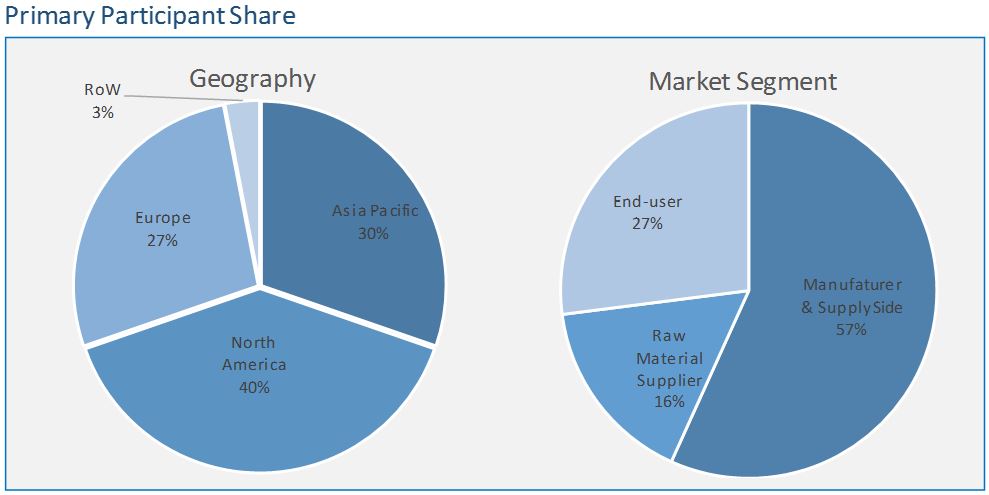
Automotive Rubber Market By Types (Natural and Synthetic Rubber), By End-user (Tire Component and Non-tire component) and By Geography – Global Driver, Restraints, Opportunities, Trends, and Forecast to 2023
- September, 2018
- Domain: Chemicals, Materials & Food - Specialty Chemicals
- Get Free 10% Customization in this Report
Growing usage of the tire and non-tire component applications is fostering the automotive rubber market growth. The companies are indulged in R&D activities to innovate and develop new products, which can open new paths of applications.
Research Methodology
The automotive rubber market has been analyzed by utilizing the optimum combination of secondary sources and in-house methodology along with an irreplaceable blend of primary insights. The real-time assessment of the market is an integral part of our market sizing and forecasting methodology. Our industry experts and panel of primary participants have helped in compiling relevant aspects with realistic parametric estimations for a comprehensive study. The participation share of different categories of primary participants is given below:

Key Market Insights
Asia Pacific is the emerging region and also has a significant share in the global automotive rubber market. Other than Asia Pacific, South America, Middle East, and developing countries of Europe have been witnessing substantial growth scenarios for automotive rubber. China and India are driving the demand for automotive rubber in the Asia Pacific region due to regional growth along with huge base of automobile manufacturers, increasing demand for non-tire components from various applications industries, and the existence of OEMs for automotive rubber. In developing regions, growing purchase power is leading the economic growth.
Globally, Asia Pacific is the largest automotive rubber market, primarily due to the presence of export-oriented manufacturing capacities and intense domestic demand from various end-user industries. The increase in the number of manufacturing industries is further driving the market growth in the region. The anticipated economic stability in Europe is expected to boost its manufacturing sector, complementing the growth of the automotive rubber market. North America is likely to remain the key region with a significant contribution from the US. Few of the prominent companies operating in the automotive rubber market are BASF SE, DowDuPont Inc., SABIC, Shin-Etsu Chemical Corp., and LANXESS.
Types:
- Natural Rubber
- Synthetic Rubber
End-users:
- Tire Component
- Non-tire Component
Geography:
- Asia Pacific
- North America
- Europe
- Rest of the World
1 Executive Summary
1.1 Asia Pacific Continues to Dominate the Automotive Rubber Market
1.2 Growing Tire Market Will Boost the Overall Automotive Rubber Market
2 Market Positioning
2.1 Industry Snapshot
2.1.1 Industry Overview
2.1.2 Key Trends
2.2 Related Markets
3 Market Outlook
3.1 Introduction
3.2 Value Chain Analysis
3.3 Market Segmentation
4 Market Characteristics
4.1 PESTLE Analysis
4.2 Porter’s Five Force Analysis
4.3 Market Dynamics
4.3.1 Drivers
4.3.1.1 Growing miniaturization in the products
4.3.1.2 Immensely Growing Demand Automotive Industry
4.3.2 Restraints
4.3.2.1 Raw material price fluctuations
4.3.2.2 Changing geo-political structure of various countries
4.3.3 Opportunities
4.3.3.1 Large untapped market in developing and underdeveloped countries
4.3.3.2 Technological developments in tire manufacturing
4.3.4 DRO – Impact Analysis
4.4 Patent Analysis
5 Automotive Rubber Market, By Type
5.1 Overview
5.2 Natural Rubber
5.3 Synthetic Rubber
6 Automotive Rubber Market, By End-user
6.1 Overview
6.2 Tire Component
6.3 Non-tire Component
7 Automotive Rubber Market, By Geography
7.1 Overview
7.2 Asia Pacific
7.3 North America
7.4 Europe
7.5 Rest of the World
(Market segmentation for geography, material type, and end-user have been covered for all the regions)
8 Competitive Landscape
8.1 Competitive Regional Exposure Analysis
8.2 Growth Strategies Analysis
8.3 Market Developments
8.3.1 Mergers & Acquisitions (M&A)
8.3.2 Expansions
8.3.3 Business Restructuring
9 Vendor Profiles
9.1 BASF SE
9.2 LANXESS
9.3 Saudi Basic Industries Corporation (SABIC)
9.4 Shin-Etsu Chemical Co.
9.5 DowDuPont
(Overview, business units, geographic revenues, product profile, recent developments, business focus, SWOT analysis, and business strategy have been covered for all the vendors)
10 Customers Profile
10.1 Toyota
10.2 General Electric (GE)
10.3 3M
10.4 Volkswagen Group
10.5 Fiat Chrysler Automobiles N.V. (FCA)
(Overview, business units, geographic revenues, product profile, SWOT analysis, and business strategy have been covered for all the customers)
11 Companies to Watch for
11.1 Asahi Kasei Corp.
11.1.1 Overview
11.1.2 Asahi Kasei to add SSBR capacity in Singapore
11.2 Covestro AG
11.2.1 Overview
11.2.1 Covestro making butyl rubber from CO2
12 Annexure
12.1 Report Scope
12.2 Market Definition
12.3 Research Methodology
12.3.1 Data Collation & In-house Estimation
12.3.2 Market Triangulation
12.3.3 Forecasting
12.4 Study Declarations
12.5 Report Assumptions
12.6 Stakeholders
12.7 Abbreviations
13 Expert’s Views
Research Framework
Infoholic research works on a holistic 360° approach in order to deliver high quality, validated and reliable information in our market reports. The Market estimation and forecasting involves following steps:
- Data Collation (Primary & Secondary)
- In-house Estimation (Based on proprietary data bases and Models)
- Market Triangulation
- Forecasting

Market related information is congregated from both primary and secondary sources.
Primary sources
involved participants from all global stakeholders such as Solution providers, service providers, Industry associations, thought leaders etc. across levels such as CXOs, VPs and managers. Plus, our in-house industry experts having decades of industry experience contribute their consulting and advisory services.
Secondary sources
include public sources such as regulatory frameworks, government IT spending, government demographic indicators, industry association statistics, and company publications along with paid sources such as Factiva, OneSource, Bloomberg among others.
